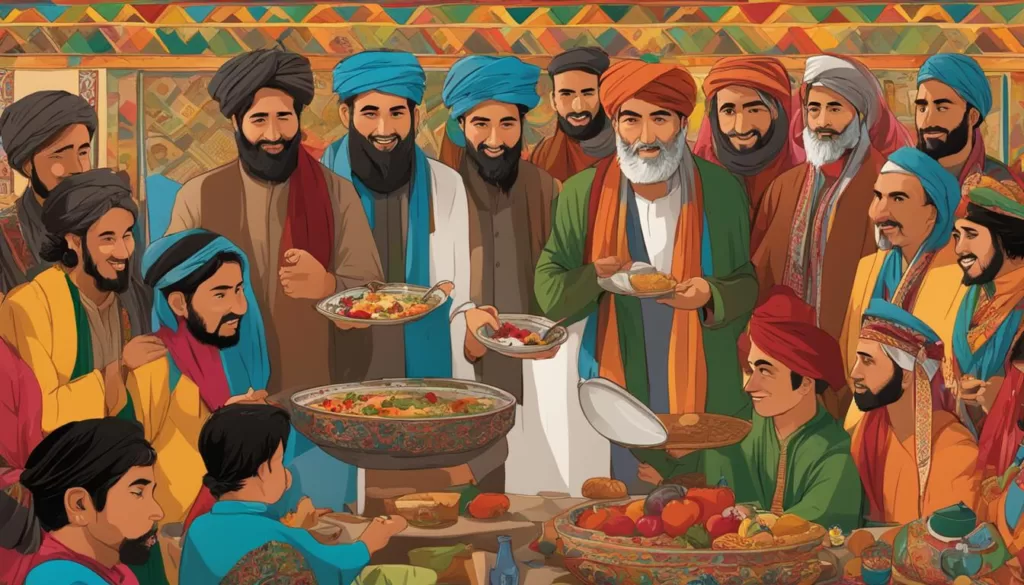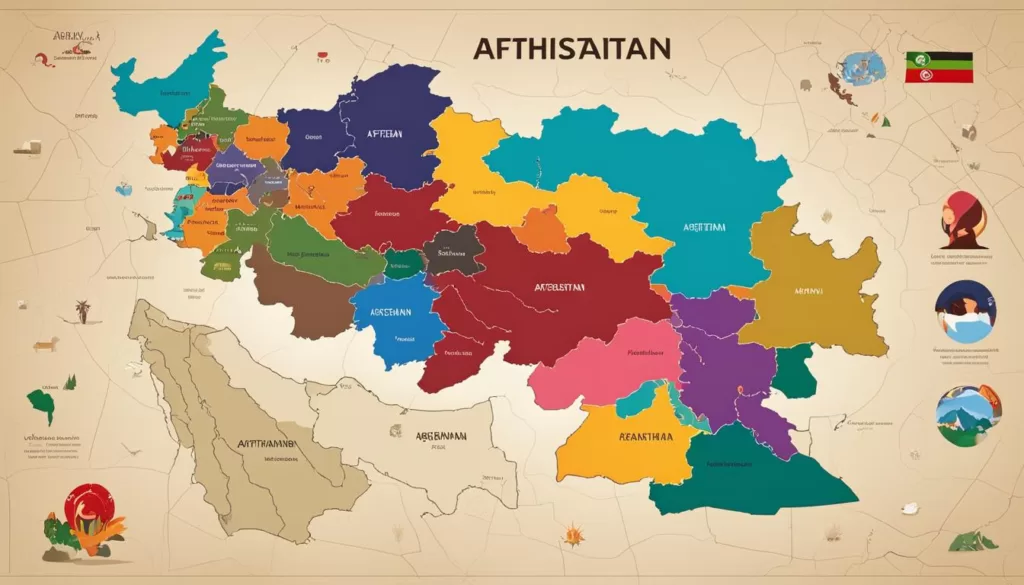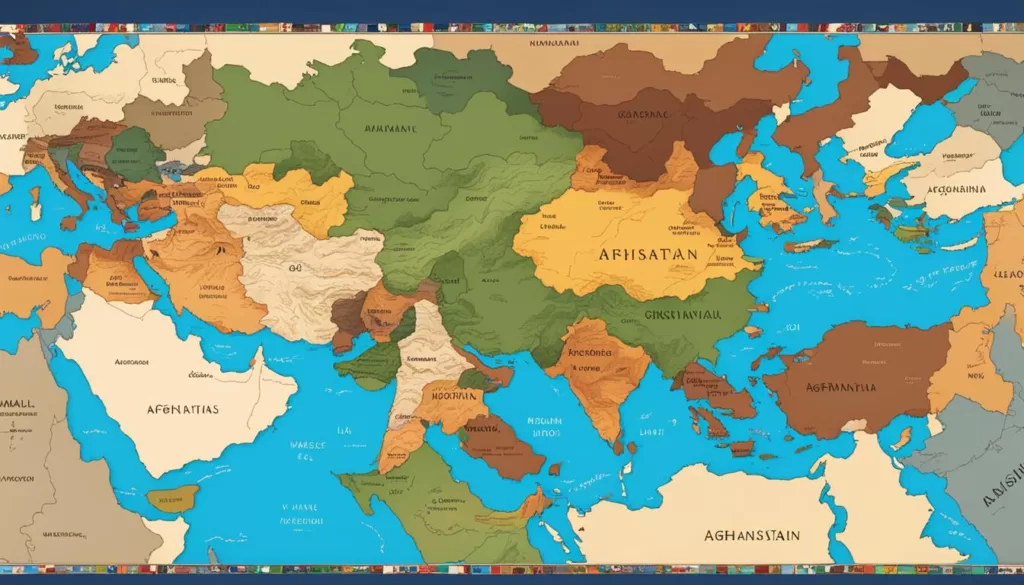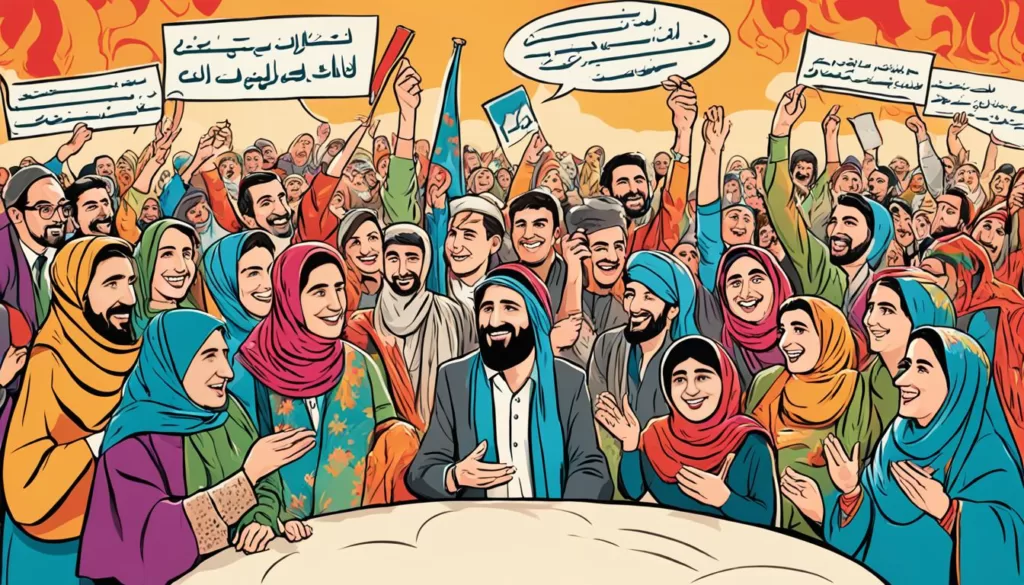The mosaic of languages spoken in Afghanistan mirrors the nation’s vibrant cultural and ethnic composition. Afghanistan’s linguistic diversity is a testament to its rich historical tapestry, with more than 40 languages etching the contours of its regional communications. Among these, Dari Persian and Pashto prominently stand out as official languages, underpinning the country’s political and educational discourse. This linguistic landscape not only showcases the intricate Afghanistan language groups but also highlights the importance of language as a cornerstone of cultural identity and societal cohesion in the Afghan context.
From the bustling streets of Kabul to the serene valleys of Nuristan, language acts as a bridge connecting the numerous ethnic groups of Afghanistan. Through the lense of language, one can glean insights into the history, social fabric, and the very essence of Afghan life. At the crossroads of strategic trade routes and civilizations, Afghanistan has witnessed the ebb and flow of many linguistic influences, which continue to shape the communication dynamics within this Central Asian hub.
Key Takeaways:
- Afghanistan’s official languages, Dari and Pashto, form the bedrock of the country’s linguistic policies.
- The lion’s share of the population speaks Dari Persian, further establishing it as the Afghanistan’s lingua franca.
- Diverse Afghanistan language groups contribute to the region’s status as a melting pot of linguistic diversity.
- Pashto language dominates amongst the Pashtun population, enriching the linguistic diversity of Afghanistan.
- English, along with other regional and minority languages, indicates the permeable nature of Afghanistan’s linguistic borders.
- Multilingualism is a common and necessary trait for navigating the social landscapes of Afghanistan.
A Glimpse into Afghanistan’s Linguistic Diversity
The rich tapestry of Afghanistan dialects and languages in Afghanistan is a vivid demonstration of the country’s multifaceted ethnic heritage. Lying at the heart of historical trade routes has positioned Afghanistan as a cultural crossroads, creating an environment where myriad Afghan language families flourish and interact. With a tradition of oral poetry and storytelling, the diverse languages of Afghanistan carry the stories and wisdom of its people through time.

Integral to the functioning of Afghanistan’s society, the co-official languages of Dari Persian and Pashto serve as the backbone for administration and communication. Dari, with its historical status as the lingua franca, unites disparate ethnic groups and facilitates interaction in a region marked by diverse linguistic landscapes. Pashto’s predominance among the Pashtun ethnic majority underscores the deep-rooted cultural affiliations in the nation.
- The warming hum of conversations in Dari Persian fills bazaars and administrative halls alike.
- Pashto rises in the chants and songs of the rugged mountains where Pashtun communities thrive.
- The markets buzz with the trade dialects of Uzbek and Turkmen merchants weaving through the streets.
- Ethereal tones of minority languages such as Balochi, Pashayi, and Nuristani, resonate in the villages dotting the Afghan landscape.
- Arabic and Urdu offer a testament to historical influences and modern interactions.
- The growth of English usage in urban centers signifies the global connections defining modern Afghan society.
In classrooms, courthouses, and in everyday conversation, these languages act as vessels through which Afghanistan’s cultural narrative continues to be written. It is within this diverse linguistic framework that a nation once torn by conflict, finds common ground and a collective identity.
Official Languages: Dari and Pashto
Exploring the linguistic terrain of Afghanistan reveals a country firmly rooted in the duality of its official languages of Afghanistan: Dari and Pashto. These languages serve not just as means of everyday communication, but as pillars supporting the nation’s unique cultural blend.
The Role of Dari as a Lingua Franca
The Dari language, an established Afghanistan’s lingua franca, is spoken by a wide array of ethnic groups, including Tajiks, Hazaras, and Aimaqs. Beyond its role in connecting these diverse communities, Dari distinguishes itself through its nine main dialects and its capacity as the common thread in Afghanistan’s multilingual tapestry. This language has carved out a space in the hearts of the Afghan people, flowing seamlessly from bustling marketplaces to the hushed corridors of governance.
Pashto: The Language of the Pashtuns
Meanwhile, the Pashto language stands as the voice of the Afghanistan Pashtun population. Nearly half of the nation’s inhabitants speak Pashto, a testament to its prevalence within this significant ethnic community. Contrasting with Dari’s widespread second-language use, Pashto’s influence is more insular, yet no less integral to the fabric of Afghan culture.
Language Policy and Regulation in Afghanistan
Afghanistan language policy has long wrestled with the dual challenges of preserving a diverse linguistic heritage while fostering national unity. The linguistic regulation in Afghanistan is framed by constitutional clauses that secure the status of Dari and Pashto, yet extend recognition to other regional tongues in locales where they predominate, illuminating Afghanistan’s commitment to linguistic plurality and cultural respect.

Below is an overview of language comprehension among Afghanistan’s population, illustrating the pervasiveness of its mother tongues in Afghanistan as well as the bilingual proficiency that is characteristic of its people:
| Language | Percentage of Speakers as L1 | Percentage of Speakers as L2 | Region Predominantly Spoken |
|---|---|---|---|
| Dari | 77% | 48% | Nationwide |
| Pashto | 48% | 25% | Eastern, Southern Afghanistan |
| Uzbek | 11% | 9% | Northern Afghanistan |
| Turkmen | 3% | 3% | Northern Afghanistan |
| Balochi | 1% | N/A | Southwestern Afghanistan |
This tableau reflects not just statistics but stories – the bilinguality etched into every column denotes a society woven together by threads of understanding, enabling unity in diversity.
Languages Spoken Afghanistan: The Lesser-Known Dialects
The linguistic tapestry of Afghanistan is rich with dialects that go beyond the official languages of Pashto and Dari Persian. Woven into the very fabric of the nation’s cultural identity, these regional dialects are intrinsic to the linguistic diversity of Afghanistan. They illustrate a history of linguistic convergence and divergence that add depth and vibrancy to the nation’s vernacular heritage. The kaleidoscope of dialects found here is a clear indicator of Afghanistan’s multilingualism, promoting a broader understanding among its people.
Regional Dialects Contributing to Cultural Richness
The myriad of regional dialects present within Afghanistan, such as those spoken by the Tajiks, Hazaras, and Aimaqs, add exquisite detail to the country’s cultural narrative. Some of these regional variations of Dari are more akin to the Persian dialects spoken in neighboring Iran, or the Tajik language of Tajikistan. This intricate network of linguistic branches underscores the impact these dialects have in enriching the country’s cultural landscape and fortifying its heritage as a cradle of linguistic diversity Afghanistan is known for.

Impact of Dialects on Afghanistan’s Multilingualism
In Afghanistan, dialects play a pivotal role in shaping the country’s communication matrix, directly influencing Afghanistan multilingualism. A profound consequence of this linguistic feature is evident in the widespread bilingualism among Afghan communities. With an environment that encourages the adoption of not just one’s native tongue but also an official or regional language, dialects foster a spirit of inclusivity and encourage social cohesion. This spectrum of languages results in an enriching experience—the dialect impact Afghanistan has experienced supports seamless exchanges across varied ethnic demographics, fostering inter-ethnic dialogue and aiding in national unity.
| Region | Main Dialect | Related Ethnic Groups | Similarities to Other Languages |
|---|---|---|---|
| Central Afghanistan | Hazaragi | Hazaras | Persian (Farsi), Dari |
| Northern Afghanistan | Aimaqi | Aimaqs | Dari, Tajik |
| Tajikistan border regions | Tajiki | Tajiks | Dari, Persian (Iran) |
| Urban areas | Kabuli Dari | Multi-ethnic | Classical Persian, Standard Dari |
The resilience and adaptability of the Afghan people are reflected in the way these dialects interact within communities, breaking down linguistic barriers and uniting disparate voices. As a result, knowledge is preserved, traditions are communicated, and Afghanistan’s rich cultural fabric continues to thrive. The dialect impact Afghanistan faces is substantial, but its role in maintaining and fostering communal ties is invaluable and a testament to the enduring spirit of its people.
Ethno-Linguistic Groups and Minority Languages
Delving into the rich cultural tapestry of Afghanistan, one finds the vibrant and diverse array of ethno-linguistic groups Afghanistan celebrates. These groups preserve a multitude of languages that emanate the stories, traditions, and distinct identities of various communities. The myriad of minority languages Afghanistan homes, stands as a testament to the nation’s variegated ethnic roots stretching across the amorphous borders into the heartland of Central Asia.
While Pashto and Dari Persian are predominant, there’s a mosaic of less-familiar tongues, fluently spinning narratives in secluded valleys and bustling markets, contributing to Afghanistan’s linguistic reservoir. Among these are languages such as Nuristani, Balochi, and a suite of Pamiri dialects, cradled in the embrace of the country’s northeastern alpine landscapes.
The linguistic quilt further extends with the warp and weft of Turkic languages — Uzbek, Turkmen, and the rarer Kyrgyz. These languages not only facilitate communication and commerce within their own communities but also connect the Afghan society with the larger ethno-linguistic sphere of Central Asia. Even the Dravidian language family is faintly but significantly woven into this fabric through the Brahui language spoken by the Brahui community, highlighting the diversity that ennobles the Afghan ethno-linguistic narrative.
| Language Family | Languages | Primary Ethnic Groups | Notes |
|---|---|---|---|
| Iranic | Nuristani | Nuristani peoples | Spoken in the mountainous Nuristan province |
| Dravidian | Brahui | Brahui community | A language isolate in the region, predominantly found in Afghanistan’s southern areas |
| Iranic | Balochi | Baloch people | A language from the Iranian branch, chiefly in southwestern Afghanistan |
| Iranic | Pamiri languages | Pamiri peoples | A collection of Eastern Iranian languages spoken in the Gorno-Badakhshan region |
| Turkic | Uzbek, Turkmen, Kyrgyz | Uzbeks, Turkmens, Kyrgyz | Central Asian Turkic languages influencing northern Afghan culture |
These languages, each unique in accented syllables and lexicon, are more than just a means of communication; they are living markers of Afghanistan’s ancient and ongoing history, its socio-cultural blooms, and its perpetual interactions with neighboring geographies. As custodians of this linguistic diversity, the various ethno-linguistic groups Afghanistan harbors, continue to ensure the survival and vivacity of their languages to pass their prized cultural heritage onto future generations.
Afghanistan’s Language Families
Diverse and historically rich, the linguistic landscape of Afghanistan is a reflection of its geographical position and complex past. The Indo-European languages Afghanistan hosts are predominantly from the Iranic and Indo-Aryan language families, which include the widely spoken Dari and Pashto. These languages serve as the primary mode of communication across the nation, representing not only the everyday interactions of its people but also the connective tissue binding the country’s myriad ethnicities.

This linguistic foundation is enriched by the influence of various historical migrations and conquests, rendering the cultural tapestry of Afghanistan both vivid and unique. The ancient Greeks, Scythians, Arabs, Turks, and Mongols left an indelible mark on the nation’s tongue, creating a robust pastiche of the Iranic languages and a lesser-known, but significant Indo-Aryan languages Afghanistan prides itself on.
Indo-European Roots: Iranic and Indo-Aryan Influences
The Iranic languages, including the prevalent Dari and Pashto, are integral to Afghanistan’s identity, fostering unity and common understanding among its diverse populations. Aligned with these are various Indo-Aryan languages, such as Nuristani, that emanate from the sequestered nooks of the country, their speakers upholding traditions that stretch back centuries.
Central Asian Ties: The Turkic Language Presence
The fabric of Turckic languages Afghanistan maintains is laced with Central Asian heritage. Languages like the Uzbek language and Turkmen language are indicative of this regional connection. These languages not only bridge communication within their own communities but also act as a thread that connects the Afghan people to the broader cultural narrative of Central Asia. The Turkic language speakers in Afghanistan are emblematic of the country’s strategic location at the crossroads of diverse worlds and times.
Dravidian Languages: A Lesser Known Segment
Tucked within the linguistic spectrum of Afghanistan is a Dravidian outlier—the Brahui language. Minority groups, particularly in southern regions, are custodians of this lesser-known but important piece of the country’s linguistic puzzle. The story of the Dravidian languages Afghanistan harbors is one of migration, resilience, and culture—a narrative seldom heard but deeply embedded in the nation’s ethnographic tapestry.
Mother Tongues in Afghanistan and Bilingualism
In the intricate tapestry of mother tongues in Afghanistan, each thread represents a story, a community, a history. Every local language blossoms from the root of a distinct Afghan culture and cements itself as the primary communicative force within ethnic spheres. Amidst this rich vernacular flora, bilingualism does not merely flourish; it serves as the lifeblood of connectivity, flowing effortlessly among the diverse peoples composing Afghanistan’s societal landscape. The phenomenon of Afghanistan bilingualism is not just a trend but a necessary facet of daily life, woven into the essence of Afghan identity.
The language profile of Afghanistan showcases a nation where multilingual competence is a standard, perhaps even an unspoken expectation. It is a land where tongues dance between languages, where children inhale Dari and exhale Pashto, and vice versa, allowing them to navigate the boundless cultural terrain of their homeland with ease. This form of linguistic dexterity not only bridges communities but is a poignant emblem of the nation’s resilient spirit.

Language statistics reveal that the majority blend their mother tongue with either Dari or Pashto, making these languages the pulsating arteries of Afghan society. Below is an illustrative breakdown of this bilingual fabric, testament to the enduring ability of Afghanistan’s people to unify in the face of diversity:
| Ethnic Group | Mother Tongue | Second Language Proficiency | Notes on Bilingual Usage |
|---|---|---|---|
| Tajiks | Dari | Pashto | Often used in trade and negotiation |
| Hazaras | Dari (Hazaragi dialect) | Pashto, Uzbek | Serves as a tool for social integration |
| Uzbeks | Uzbek | Dari | Frequently employed in education and government services |
| Pashtuns | Pashto | Dari | Crucial for political and administrative participation |
| Nuristanis | Nuristani languages | Dari | Cultural preservation alongside national engagement |
The strategy of embracing both local dialects and pervasive national languages stands as an affirmation of Afghanistan’s commitment to educational and economic growth. Such a bilingual ecosystem not only reflects the necessity of the phenomenon but also celebrates its inherent virtues. Afghanistan’s linguistic tableau is thus not merely an academic or cultural footnote; it is the dynamic force propelling the country toward an inclusive and unified future.
In essence, the nurturing of mother tongues in Afghanistan alongside the elevation of bilingual competencies is a stirring ode to the nation’s collective soul. It is this harmonious symphony of languages that assures that every Afghan can communicate, connect, and contribute to the greater narrative that is Afghanistan.
The State of Endangered Languages in Afghanistan
Among the rich tapestry of languages in Afghanistan, there lies a concerning aspect of cultural erosion—the plight of endangered languages. The journey towards linguistic preservation in Afghanistan has been arduous, imbued with the need to uplift voices that are at the brink of silence. It is within this context that we find a blend of international commitment and local endeavors striving to protect the nation’s profound linguistic diversity.
Promoting Linguistic Preservation
Recent shifts in language policy and educational initiatives have emboldened the quest for endangered languages support in Afghanistan. With the realization that every language is an irreplaceable thread in the cultural fabric, there has been a concerted move towards recognizing and valorizing the multiplicity of languages spoken within Afghanistan’s borders. Regional languages are not only acknowledged but are now interwoven into the administrative and social tapestry of their communities.
UNESCO’s Role in Protecting Afghanistan’s Linguistic Heritage
The watchful eye of the United Nations Educational, Scientific and Cultural Organization (UNESCO) has been pivotal in protecting minority languages in Afghanistan. UNESCO’s ambition to cast a global spotlight on the country’s endangered languages has been instrumental in galvanizing support and awareness for these vulnerable linguistic treasures.
| Language | UNESCO Status | Speakers in Afghanistan | Notes |
|---|---|---|---|
| Parachi | Definitely Endangered | 3,500 | Unique words and phonetics enrich its cultural value. |
| Brahui | Vulnerable | Speakers across Afghanistan and Pakistan | One of the few Dravidian languages spoken outside of South Asia. |
| Pashayi | Vulnerable | 400,000 | Rich oral traditions worthy of preservation. |
| Munji | Severely Endangered | 5,300 | A unique sound system distinct from other Iranian languages. |
| Nuristani | Varying status across dialects | Populations largely in Nuristan Province | Serves as a linguistic bridge between Indo-Iranian lineages. |
Supporting the UNESCO linguistic heritage Afghanistan proudly upholds is more than an act of conservation; it is a beacon of hope for these languages to not only survive but to thrive in the modern age.
Conclusion: The Linguistic Harmony of Afghanistan
In the intricate mosaic that forms Afghanistan’s linguistic identity, every dialect, from the dominant Pashto and Dari to the vernaculars of the Nuristani and Pamiri, has been woven with threads of history, culture, and heritage. The rich array of over 40 languages spoken across the country is more than a statistic—it is the lifeblood of the nation, encapsulating its ethnographic diversity and resilience. As Afghanistan navigates through changing socio-political landscapes, the enduring presence and continued evolution of its languages stand as a testament to the indomitable spirit of its people.
Efforts towards the preservation of this linguistic heritage are not just vital; they are imperative for maintaining the cultural integrity and identity of future generations. Policies that support and protect these languages are assets in the safeguarding of Afghanistan’s diverse ethno-linguistic narrative. From the local to the global stage, prioritizing these minority tongues is essential to ensure they endure not merely as echoes of the past but as vibrant voices in the chorus of modernity.
Ultimately, the tapestry of tongues that is Afghanistan’s linguistic landscape continues to be embroidered with each passing day. The story of its people, their interactions, and identities are intricately tied to the languages they speak. As we appreciate the rich linguistic palate of this nation, we see not only a repository of words and syntax but a harmonious symphony of collective human experience, poised to enrich the global cultural dialogue.
FAQ
What languages are spoken in Afghanistan?
Afghanistan is a multilingual country with over 40 languages spoken. The official languages are Dari Persian and Pashto. Other languages include Uzbek, Turkmen, Balochi, Pashayi, Nuristani, and Pamiri, with numerous dialects and minority languages such as Brahui also present.
What are the official languages of Afghanistan?
The official languages are Dari Persian and Pashto, which serve as the primary languages for government and official communications.
How do Dari and Pashto function within Afghan society?
Dari serves as a lingua franca facilitating communication among different ethnic groups, while Pashto is predominantly spoken by the Pashtun majority. Both have significant cultural and administrative roles in society.
What is the significance of Dari as Afghanistan’s lingua franca?
Dari Persian is the most widely understood language in Afghanistan, enabling people from different linguistic backgrounds to communicate with each other, thereby strengthening social cohesion and unity.
Who are the primary speakers of Pashto in Afghanistan?
The Pashtuns, who constitute the dominant ethnic group in Afghanistan, predominantly speak Pashto.
How does Afghanistan’s language policy regulate its linguistic diversity?
Afghanistan’s language policy recognizes Dari and Pashto as official languages and grants official status to other regional languages in areas where they are predominantly spoken. It supports the rights of minority language speakers and aims to preserve the country’s linguistic heritage.
Are there dialects in Afghanistan that contribute to its cultural richness?
Yes, there are various regional dialects of Dari and other languages that contribute to Afghanistan’s rich cultural tapestry. These include variations spoken by the Tajiks, Hazaras, Aimaqs, and others.
How does bilingualism impact Afghanistan’s linguistic landscape?
The extensive range of dialects leads to widespread bilingualism, with many Afghans speaking both their native language and a second language or dialect, facilitating inter-ethnic communication and unity.
What are the predominant ethno-linguistic groups and minority languages in Afghanistan?
Afghanistan’s ethno-linguistic groups include the Tajiks, Hazaras, Uzbeks, Turkmen, Balochs, Pashayis, and Nuristanis. Minority languages include various Pamiri languages, as well as others like Uzbek, Turkmen, Kyrgyz, and Brahui.
How do language families like Iranic and Indo-Aryan influence languages in Afghanistan?
The majority of languages spoken in Afghanistan are part of the Iranic and Indo-Aryan language families, reflecting the historical and cultural influences of the region.
What role do Turkic languages play in Afghanistan’s linguistic diversity?
Turkic languages like Uzbek and Turkmen link Afghanistan to Central Asian cultures, showcasing the historical connections and migrations that have shaped the country’s linguistic landscape.
Can you tell me about the Dravidian languages spoken in Afghanistan?
The Dravidian language family is represented by Brahui, spoken by a smaller community primarily in the southern part of Afghanistan, illustrating the country’s diverse ethnic history.
How prevalent is bilingualism in Afghanistan?
Bilingualism is quite prevalent, as many Afghans are fluent in their mother tongue and one of the official languages or a regional dialect. This linguistic capability fosters a sense of shared national identity and cultural unity.
What efforts are made to preserve endangered languages in Afghanistan?
The Afghan government and international organizations like UNESCO are working towards linguistic preservation by officially recognizing regional languages and taking measures to prevent the disappearance of endangered languages.
What is UNESCO’s role in protecting Afghanistan’s linguistic heritage?
UNESCO works to protect linguistic heritage by identifying and classifying endangered languages and collaborating with local institutions to develop strategies for their preservation and revitalization.






